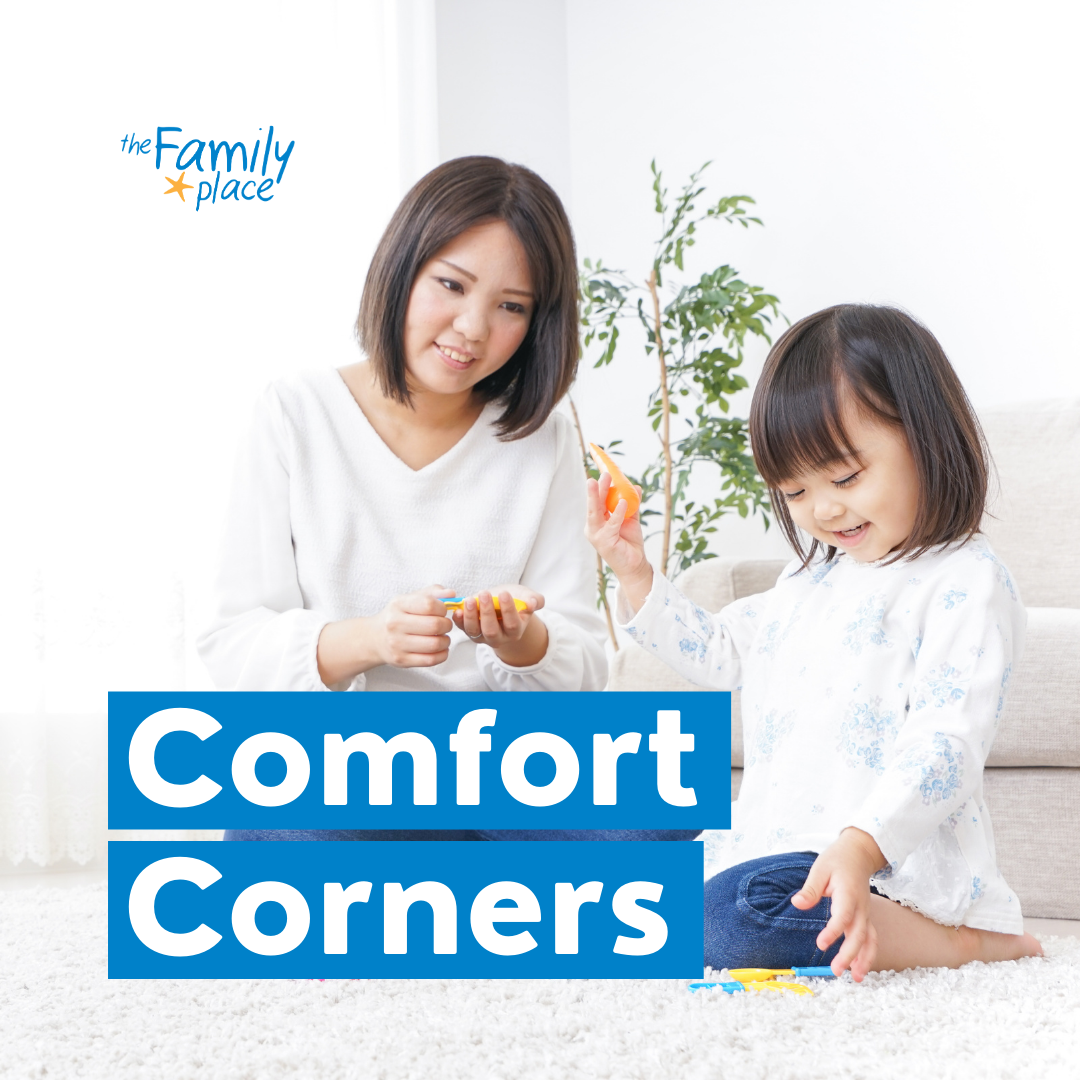Emotions are a part of every day life. Emotions are there with us from the beginning, like when a child yells and screams in a grocery store because they want a specific toy or when a they fall down on the playground and begin crying. As we have grown older and experienced more emotions, we learn how to sense our feelings and react in an appropriate way. Caring for children is challenging, especially when children are still learning about their emotions. As caregivers, we can teach about emotional regulation to help children work through big behaviors, and ultimately reduce stressful challenges in the home. The Comfort Corner, or Comfort Spot, is a safe space for children and caregivers to come together and learn about their emotions.
Energy and a Comfort Zone
Before creating a Comfort Corner, you must understand energy. Energy is best described as a sensation in your body that serves a purpose. Your energy can be low, medium or high and comfortable or uncomfortable. Try asking “Where is your energy? Are you comfortable or uncomfortable?”. Different energies are good for different tasks. For example, low energy is needed to fall asleep, but high energy is needed for playing a fun game of soccer. Also, the comfort zone is different for everyone! For some people, they may work best with medium, comfortable energy. There is no wrong energy! However, some energy levels may not be effective for specific tasks. For example, a child with high energy may be uncomfortable sitting down at the table for a snack. Also, children who are typically quiet may be uncomfortable in their energy, whether it is high, medium or low, during a task at school that involved public speaking. For children, it may be easier to talk about their energy versus what specific emotion they may be feeling.
Why the Comfort Corner?
What happens if their energy is uncomfortable or inappropriate for the activity? The Comfort Corner is space for caregivers to openly discuss energy, teach about feelings, and participate in activities that can regulate their emotions with children. Teaching is done while you are in your comfort zone! With that in mind, if a child’s energy is uncomfortable and they are having a big behavior, they first need to bring their energy to a comfortable level before learning about how they can appropriately act in that specific situation.
Say the children in The Family Place’s Kid’s Place are all sitting together to do puzzles. One boy is bouncing up and down with high energy. His energy is getting uncomfortable and he begins to throw puzzle pieces. The staff member will ask them if he would like to take a break. As the staff and the boy enter the Comfort Corner, the staff will ask about energy. The child doesn’t understand that they may be feeling angry because it was time for puzzles. However, the staff can say “It seems like your energy is uncomfortable”. Stating the energy or feelings will help teach them, even if they do not fully understand them until later.
The goal at this point is to participate in an activity that will make his energy more comfortable. Since his energy is high, maybe he will want to jump or throw a ball back and forth. Once his energy is more comfortable, they can do something together that can lower his energy, to make it more appropriate for the activity that is planned.
How do you Incorporate it in your home?
The Comfort Corner will look differently for every child! First, think about the space. The Comfort Corner can be in a corner of a room, in a closet, or even in a tent. This space includes specific activities that will allow a child to explore their feelings and actively pursue a calm state. This can be different for every child. If your child is old enough, work with them to see what they would like to include. Typical Comfort Corners have pillows, blankets, and modulations items such as playdough, fidget spinners, blocks, books, or even stuffed animals.
Once you have your space ready, it’s time to take a break! Caregivers are encouraged to take a break in the Comfort Corner as well! This will allow them to teach their child emotional regulation, strengthen their connection and give them an opportunity to regulate as well.
Now that you are in the corner, start with a check in. Where is your energy? Where is theirs? Pick an activity that will help move their energy to a more comfortable zone. Senses play a critical role in helping a child return to their comfort zone. These can mean squeezing a soft cuddle animal, listening to music, or even patiently watching glitter gently float to the bottom of a bottle. This is also a safe space to talk and build trust!
The amount of time spent in a Comfort Corner is different for everyone. At some times, maybe you set a timer to be in there together for two or five minutes. Or maybe you just sit in the Comfort Corner together until you are ready to leave.
Once you are done, check out! How does your energy feel now? Teach them why! “My energy was uncomfortable. But now after sitting and playing with the playdough, it feels comfortable and low.” If your child entered the Comfort Corner after a big behavior, teach them how to react appropriately.
Do not forget to create guidelines or values for the Comfort Corner that will keep the space safe and comfortable. For example, The Family Place Utah follows these six guidelines in their Comfort Corner.
- Only one child should be in the Comfort Corner at a time.
- Children must be with an adult.
- Be safe and follow directions.
- Complete an emotional check-in and check-out (using emoji pictures or thermometer to label feelings).
- Items in the Comfort Corner must stay in the Comfort Corner.
- Clean up before leaving.
Ultimately, the Comfort Corner will look different for every child and at different points in their life. But implementing a Comfort Corner will build trust and open up conversations about the needs of your child. Because every behavior communicates a need!
Create Lasting Positive Experiences!
In recognition of April’s Child Abuse Prevention Month, we want to show that prevention is possible and it starts with us. We have the power to create and promote positive childhood experiences for our children and the children in our community. These positive childhood experiences taught in the Comfort Corner will last a lifetime.
Success Stories from The Family Place
A client that I was working with had a 5 year old daughter who went to the Kid’s Place. The Comfort Corner there was a closet. My client noticed that when her daughter got overwhelmed, upset, angry, or just needed space to herself, she would take a Barbie and go into her mom’s closet. She would stay for a little while and come out feeling better and ready to engage with the rest of the family. She had created her own Comfort Corner in her home!”
Brandy Mouritsen, Family Educator
When twin sisters started using the Kid’s Place weekly care they had a hard time focusing, sharing their toys, and often would hit or push each other. We would try to keep them separate during activities and had to take many breaks with each of them in our comfort corner to help regulate their emotions.
Kourtney Bonzo, Kid’s Place Staff
They have come so far! Their focus has increased and they have been more kind to each other. Through the use of positive reinforcement and teaching emotional regulation they now can play toys together, do art with the rest of the group, and are even taking less breaks.”
Resources
The Parent’s Place Podcast – “Energy with Brandy Mouristen” and “The Comfort Corner Technique with Candice James”
Norman V, Juhasz A, Useche K, Kinniburgh K, 2021, ‘”How Are You Feeling” Strategies for Helping Children Understand and Manage Emotions’, National Association for the Education of Young Children, vol. 76, no. 1, pp. 63-68.
Bethell C, Jones J, Gombojav N, Linkenbach J, Sege R. Positive Childhood Experiences and Adult Mental and Relational Health in a Statewide Sample: Associations Across Adverse Childhood Experiences Levels. JAMA Pediatr. 2019;173(11):e193007. doi:10.1001/jamapediatrics.2019.3007









0 Comments